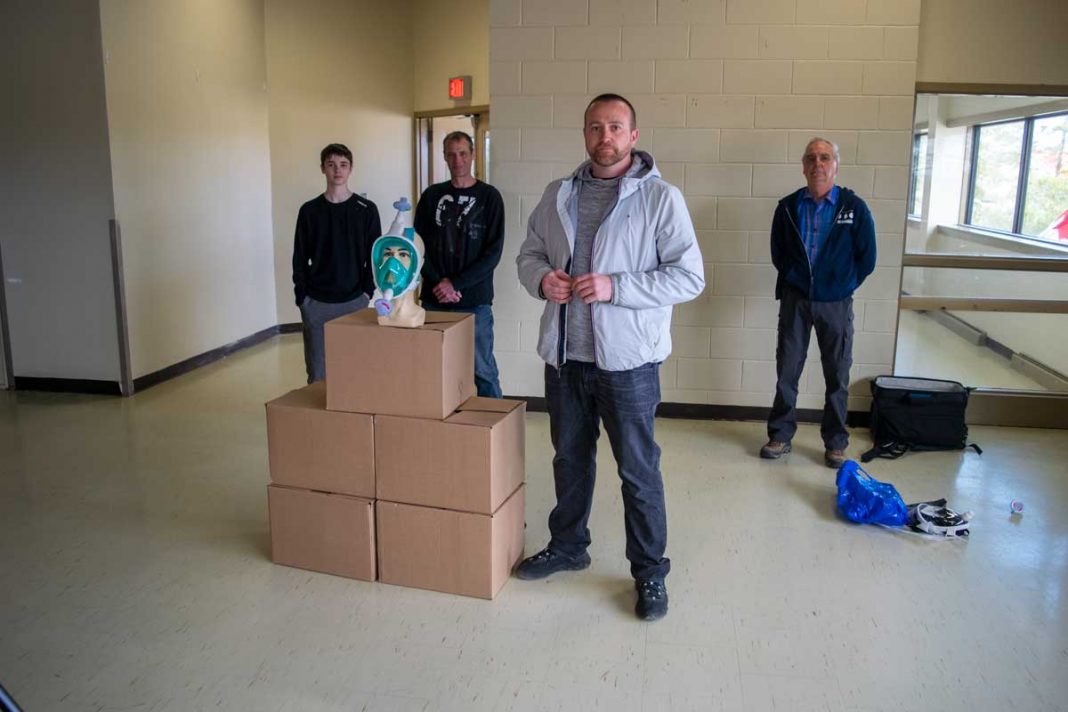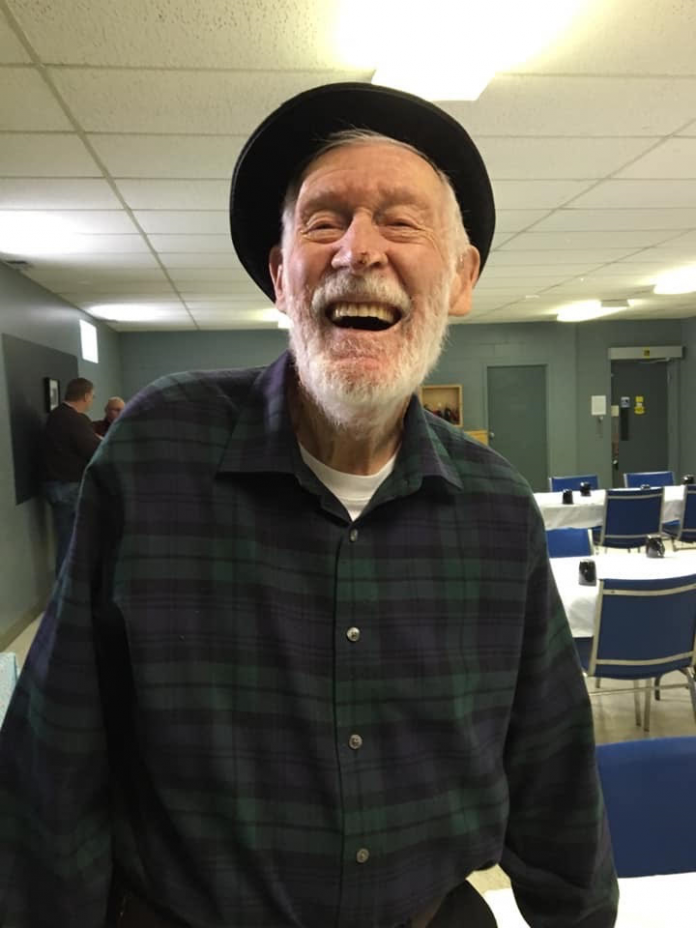LITTLE CURRENT—Manitoulin Health Centre (MHC) is the first hospital to secure an order of newly re-engineered full-face snorkel masks by CanCOV Medical Inc., a partnership between Toronto snorkel mask manufacturer CobraMask and fixture design and Oshawa certification company CMM Precision, which worked with Mindemoya’s Bill Cranston to develop a life-saving tool to help stop the spread of COVID-19.
“It’s really amazing. I’d never thought in a million years that my masks would be used for this. Personal protective equipment (PPE) is the most in-demand item in the world right now and I’m glad to be part of it,” said CobraMask founder Jeremy Hannan, who is a co-founder of CanCOV Medical.
Mr. Hannan had seen a similar solution from an Italian manufacturer of similar masks and resolved to develop a product for his design. He contacted David Follest, the owner of CMM Precision, a dimensional measurement lab that certifies fixtures for use in medical, aerospace and military applications among many others. Mr. Follest is the other co-founder of CanCOV Medical.
Because this innovative product is only a week old it has not been certified by Health Canada for use, but the manufacturers expect the device to eventually pass inspection. CMM Precision routinely certifies medical products and engineered the mask modifications following Health Canada guidelines.
In the April 8 edition of The Manitoulin Expositor, the front-page story ‘Island paramedic re-engineers snorkel masks to deliver oxygen, protect front line medical staff’ described how Mr. Cranston, a retired paramedic in Mindemoya, partnered with MHC medical staff president Dr. Mike Bedard in his home workshop to turn a full-face snorkel mask into a unit that could feed oxygen to patients and be worn by medical staff to filter the air they breathe. Exhalation filters were added to further reduce the virus’ spread.
Mr. Hannan saw the story online, noticed that the two had used a CobraMask for their home-brew project, and contacted this newspaper for Mr. Cranston’s contact information. They have been collaborating ever since.
Both Mr. Cranston and Dr. Bedard were at the Little Current field hospital site, which has yet to see any patients, when Mr. Hannan, Mr. Follest and his son Jake Follest travelled from southern Ontario to personally deliver the first 50 units for MHC on Monday, April 20.
“Mike and Bill deserve all the credit for advocating for our communities and ensuring Manitoulin Island was prepared, even though they faced much opposition at the start. We wouldn’t be as far ahead without them,” said MHC VP of clinical services and chief nursing officer Paula Fields.
“We’re very grateful we have people on our Island who are so community-minded. None of this would have happened without them,” added MHC VP of corporate support services and chief financial officer Tim Vine, who was also present for the delivery.
MHC became the first hospital to directly receive an order of these units from CanCOV. Mr. Hannan said he wanted to make sure MHC was right near the top of the list because of how closely the health centre has worked and continues to work on the development of this product. He planned to create a survey for patients and medical staff members who end up using the mask so he can improve future versions.
“Big centres are probably going to be getting assistance before rural and Northern communities, and I’m so glad we’re here working with MHC,” said Mr. Hannan.
Mr. Follest and Jake worked together to create a handful of prototypes, making fine adjustments to the details as they worked. It only took three rounds of testing and making adjustments before they found an adapter that would work for their purposes.
These masks are intended principally for a health care setting, and Mr. Hannan said he would not be taking personal orders until all medical orders can be filled. However, he said the masks have many uses beyond COVID-19-positive patients.
“I’d like to see these put on someone as soon as they enter a hospital waiting room because you don’t know who might have (COVID-19),” said Mr. Hannan, adding that the masks would benefit long-term-care workers, personal support workers, grocery store and other essential workers and people living with someone who has an infectious airborne disease.
The masks themselves have detachable modules to hold filters and connect a range of equipment, such as oxygen lines and attachments to maintain positive airway pressure.
Mr. Hannan had to make some modifications to his existing CobraMask design to better suit it for clinical use. A one-way mushroom valve for exhaling used air was removed in place of the exhaust filter, and the mask’s built-in GoPro mount was taken off.
“We actually think we’re going to be putting the GoPro mount back on,” said Mr. Hannan; no, not for the next hit reality show (although CobraMask was featured on Dragon’s Den two years back), but because users such as dentists could mount LED lights to that plate which they need to do their work.
The filter holders are detachable from the mask and they support small N100 filters (which eliminate 99.97 percent of particulate matter, as opposed to the gold-standard N95’s filtration rate of 95 percent). Oxygen lines can be fitted to the filter housings themselves, a major upgrade to Mr. Cranston’s design that he was struggling to solve on his own.
The mask and the filter housings are made of UV-safe plastic and can be sterilized using medical-grade ultraviolet germicidal irradiation treatments, making the whole system quickly reusable. The masks can be immersed in warm sterilization solutions, though the hottest-temperature steam treatments can melt the plastic so UV sterilization is likely to be the best way to sanitize the units.
Mr. Hannan and Mr. Follest said their companies are working well together particularly because they’re both Canadian manufactures working to address the needs of the Canadian population. All the modified parts are 3D-printed and assembled in Canada, such as the filter-holder assemblies used in testing that came from Agile Manufacturing.
Although he was jokingly introduced to the group at the field hospital as the human model for the product, Jake was an integral part of the development of CanCOV’s emergency mask. The 14-year-old is adept at computer-aided design (CAD) and web development. Mr. Follest estimated that Jake was responsible for 40 percent of the CAD work on the mask attachments and he also built CanCOV’s website which launched the night before the delivery.
“Back when I was in Grade 3 or 4 my dad brought in a 3D printer to my class,” Jake said. “We’ve done four weeks of 16-hour days to put the whole project together from the concept to the design.”
It helps to grow up with parents who are “the only people in North America who have a CMM lab at our house,” said Mr. Follest. For Jake, who has high-functioning autism, it has jump-started his career and he has already been receiving high-paid job offers. Not bad for someone who’s barely at the threshold of high school.
CanCOV said it was looking to turn its creation into the new standard for health care protection, since the fully sealed design addresses shortcomings of other products such as partial-covering face shield visors and respirator masks that need to be individually fitted and disposed of after use.
Orders have been steadily coming into the company. Mr. Hannan said he would likely fulfill 2,000 in the coming weeks but said he was working to increase production capacity to meet the intense demand.
More information about this new product that was created in partnership with Manitoulin Islanders can be found at CanCOVMedical.ca.





